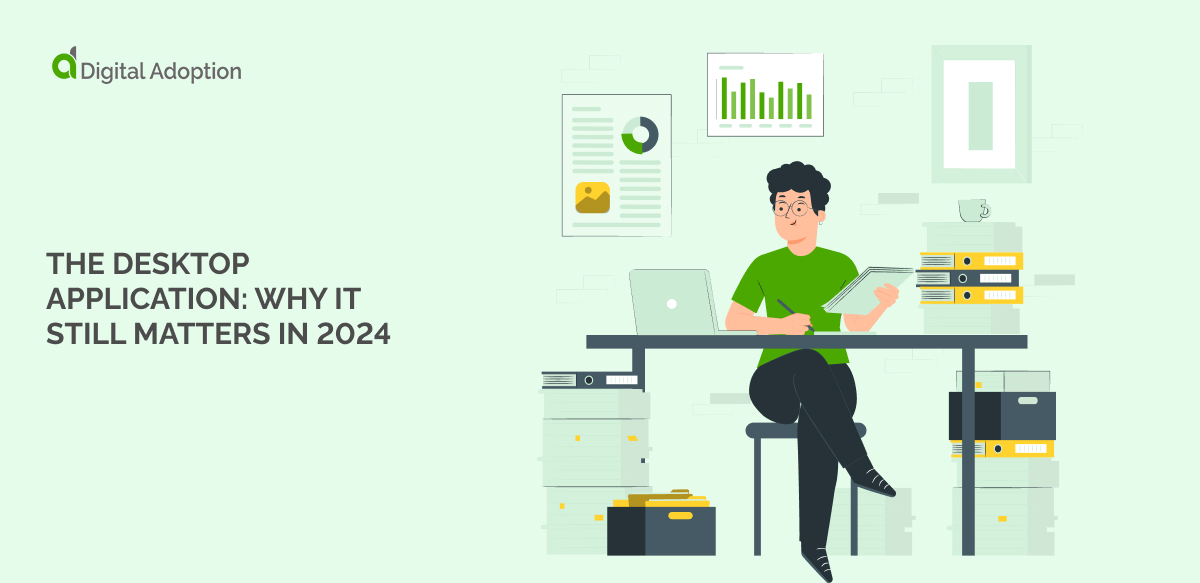You won’t be alone if you feel that the age of the desktop application and all its manual installation and update requirements have ended.
But this is not the case, as there are still many benefits to using a desktop app and system software, making it helpful to learn the differences between them and a web application.
In this article, let’s explore the desktop application via examples and use cases via the following topics:
- What is a desktop application?
- How is a desktop application different from a web-based application?
- Desktop application examples
- How do you integrate a DAP with a desktop application?
- Use cases for the desktop application
What is a desktop application?
Local software programs for computers are called desktop applications. They can’t be used through an internet browser like web apps, making them the opposite of mobile applications. You must install and update desktop applications on desktop or laptop computer devices.
What are the benefits of a desktop application?
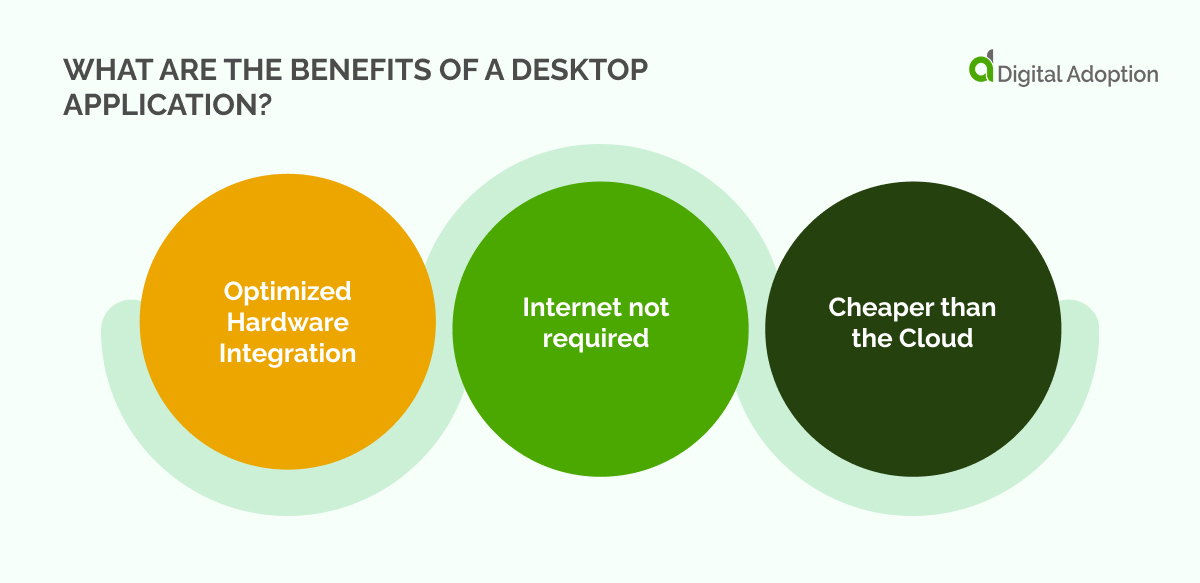
Although it may not be common, there are many benefits to using desktop applications over Cloud apps. The first of these benefits is optimized hardware integration that desktop apps utilize via the operating system using system resources.
Optimized Hardware Integration
Installing the appropriate version of the desktop program ensures that it integrates seamlessly with your system.
Using a program designed for your hardware ensures smooth operation on your machine. Additionally, desktop apps can provide faster performance and a more comprehensive range of features than web-based applications.
Internet not required
The World Wide Web is the main distinction when comparing desktop and web solutions. If you install a desktop app on your PC, you do not need an Internet connection. This difference makes desktop apps more convenient when traveling or in places with limited connectivity.
Cheaper than the Cloud
You can save your private data using desktop applications on your local device instead of using a service on a cloud-native platform. This feature offers better protection from hackers’ attacks and eliminates the risk of losing personal information offline.
Desktop applications are also recommended for sharing intellectual property, such as articles or songs, as they allow complete copyright protection. Remember, all rights are reserved.
What are the challenges of a desktop application?
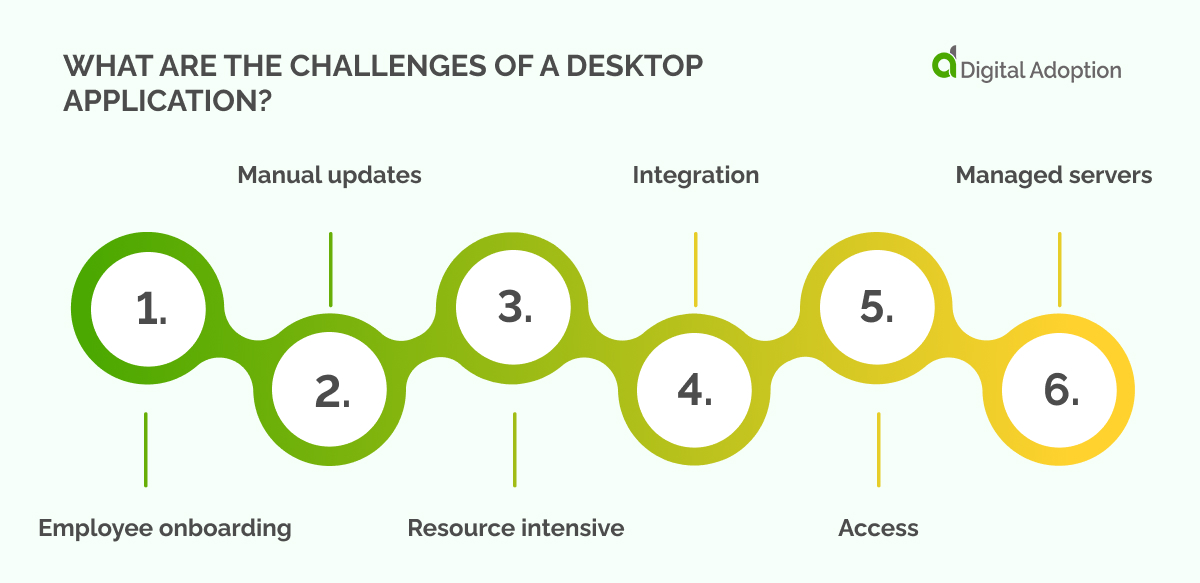
It’s essential to be aware of potential challenges when buying a desktop app for your internal team, as they can have flaws and may not work perfectly in every scenario.
1. Employee onboarding
Employee training using a desktop application can be time-consuming and challenging, and although desktop applications offer many features, they may be challenging to navigate.
Creating a comprehensive digital onboarding program is essential to help your team learn the new application quickly when introducing it, increasing productivity, motivation, and employee retention.
2. Manual updates
Desktop software requires manual updates instead of self-updating like web SaaS apps.
You must provide permission and update apps manually to access the most recent versions, which could disrupt business processes and workflows and be time-consuming.
3. Resource intensive
You must provide your employees with modern, powerful machines to use desktop apps effectively, and sophisticated solutions typically require high-performance hardware to run without disruptions.
Providing your staff with inadequate equipment to meet the needs of their desktop apps will result in reduced employee productivity and performance.
4. Integration
Integrating multiple web applications does not require technical expertise. In most cases, you can use the pre-built integrations or create basic workflows using Zapier.
However, if a desktop application does not have this feature, it may be impossible to integrate it with external technologies.
5. Access
To use desktop applications, you must install them on your device. Therefore, you must assist everyone with the installation and setup process to incorporate a desktop software solution into your system.
Additionally, you cannot access the application if you are not using your business laptop.
6. Managed servers
Desktop applications typically need a server to manage the stored data. You must pay for and maintain a server, which can be costly and add to your system administrators’ workload.
How do you integrate a DAP with a desktop application?
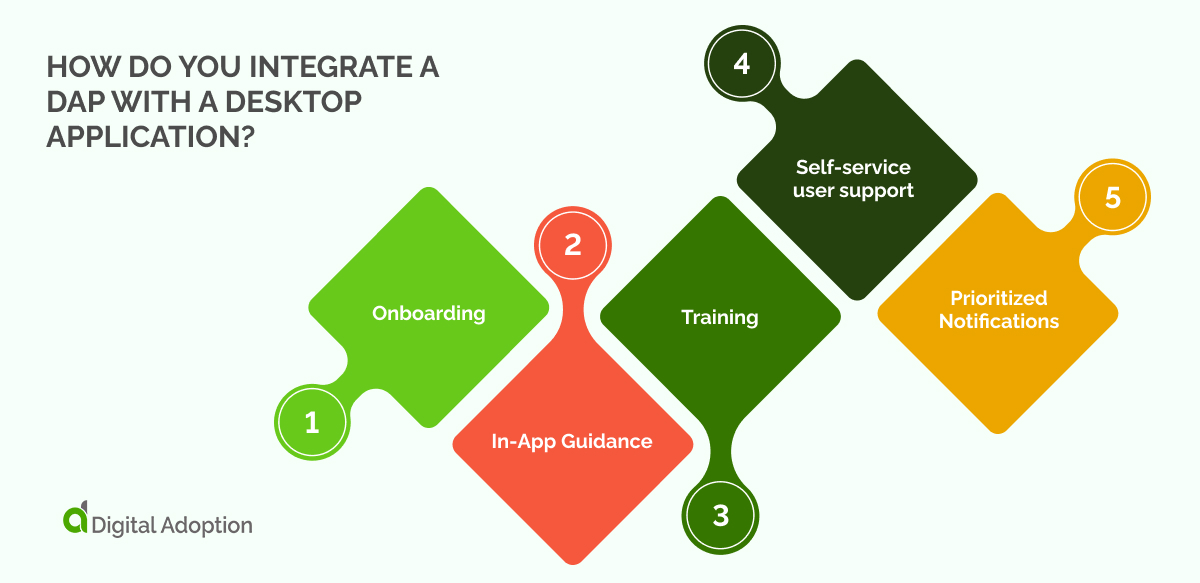
To successfully adopt a new desktop app, it’s essential to have a digital adoption strategy that outlines the platform’s overview, use cases, best practices, and troubleshooting tips.
Depending on the app’s complexity and size, you may need to run a workshop, create a video software tutorial, add documentation to your knowledge base, and provide in-app training. In-app training is essential for organizations that want to adopt new technology efficiently without spending too much time on in-person training.
You should use a digital adoption platform to create a personalized training program within your app.
You can use a DAP to train your teams on new digital tools in five ways.
Onboarding
Designing intuitive interfaces is essential to help users quickly understand and use desktop apps. One way to achieve this is by creating onboarding flows and introducing new users to the platform.
A brief product tour can help users navigate screens and tabs and quickly become familiar with the application. You can also include images and videos to provide additional support and help explain any concepts.
In-App Guidance
One of the main benefits of a DAP is that it allows you to make interactive tutorials for any process and integrate them into your application interface.
Simply link your desktop app to the DAP and add your content. From there, it will handle everything else automatically, as it excels when asked to perform specific tasks to streamline your digital adoption process.
Training
With features of your DAP, like analytics and task lists, you can create a training plan for your employees and monitor their progress. This feature list includes assigning tasks to individuals, setting learning goals, sending reminders, and monitoring app adoption.
Self-service user support
With the self-help features of your DAP, users can request on-demand assistance from within the application. The self-help widget compiles possible answers to queries from various sources, such as the knowledge base or DAP content, and presents them in a menu that is accessible to users at all times.
Prioritized Notifications
The DAP lets you notify app users of updates and reminders through pop-up notifications. The pop-ups will be shown on the user’s desktop, ensuring everyone receives essential information or urgent announcements.
3 use cases for the desktop application
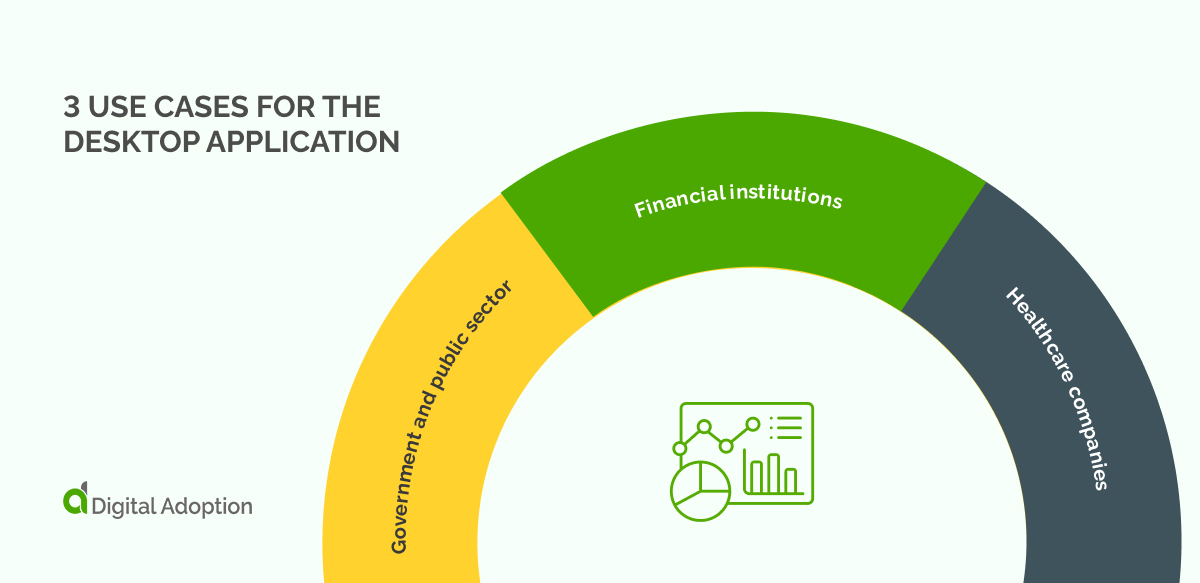
It’s helpful to consider how desktop applications can apply to many fields. Let’s look at how to use desktop applications in the public sector, financial institutions, and healthcare.
1. Government and public sector
Government and public sector organizations can use desktop applications to protect sensitive data and decrease the likelihood of cyber attacks. Some of the software solutions they could use include:
- Contractor management systems: Government organizations frequently collaborate with contractors as a secure means of managing outsourced projects.
- Employee management software: These are systems used for workforce management. They allow government and public sector companies to monitor employee performance, assign tasks, store employee data, and streamline payroll processes.
- Document management applications: Government organizations are increasingly working to become paperless by digitizing their document management. Using these applications eliminates the requirement of managing physical paper and establishes a contemporary digital space for storing electronic documents.
2. Financial institutions
Financial institutions like banks and insurance companies prioritize data safety and uninterrupted processes. These companies use desktop applications, such as the ones mentioned here, more frequently.
- Core banking software: These systems provide a digital infrastructure that covers all banking operations, including client management and fraud prevention.
- Underwriting software: Insurers and loan companies use these solutions for case management and lending decisions.
- CRM software: In banking and insurance, CRM systems combine customer data from various software solutions to give a unified view of each customer profile.
3. Healthcare companies
Healthcare organizations such as hospitals and private clinics use desktop applications to safeguard their patients’ sensitive information.
Here are some examples of desktop applications commonly used in the healthcare industry:
- Electronic health record (EHR) software: This software aids clinics in organizing patient information, maintaining medical records, and streamlining processes, similar to a customer relationship management (CRM) system used in other industries.
- Medical database software: This software differs from EHR software because it focuses on creating a comprehensive medical database by analyzing disease and treatment data. This database aims to study drugs’ side effects and benefits and improve treatment plans accordingly.
- Medical equipment management systems: These tools assist healthcare organizations in overseeing equipment functionality, arranging maintenance, and creating repair requests.
Although the three industries mentioned are commonly associated with desktop applications, other industries, such as restaurants and physical shops, also use desktop applications to facilitate smooth customer-facing processes (such as transactions) and provide a positive customer experience.
Use a DAP to adopt your new desktop application
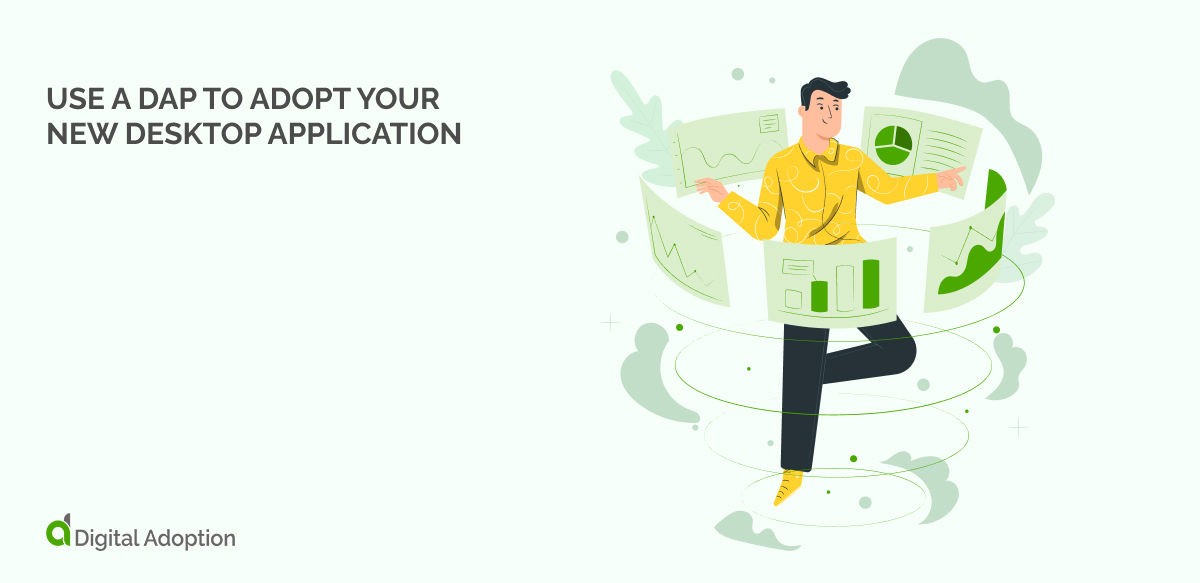
A desktop application offers a range of advantages for businesses compared to web-based applications. They are user-friendly, easily integrated with other software, and highly secure. With multi-platform compatibility, you can use desktop applications with all operating systems and computers.
Businesses can use a DAP to adopt a new desktop application to improve user experience with improved efficiency and data security. Desktop applications offer an effective solution for small business enterprises and larger organizations looking for optimum user experience from their application.

